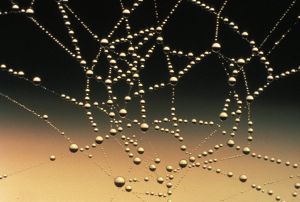Condensation
 From Nwe
From Nwe Condensation is the change in phase of a substance from a gas (or vapor) to a liquid.[1] It occurs when a vapor is cooled or compressed or subjected to both cooling and compression.[2] Liquid that is formed by condensation of a vapor is called the condensate.
The phenomenon of condensation occurs regularly in nature. For example, clouds are formed by the condensation of water vapor in the atmosphere. Thus, condensation is an important process in the hydrologic cycle (water cycle). Also, the water seen on the outside of a cold glass on a hot day is condensation. In fundamental research and industrial processes, condensation is used in conjunction with distillation, as a means of separating a substance from a mixture.
Condensation of water in nature
When water vapor from the air naturally condenses on cold surfaces into liquid water, it is called dew. Condensation of water vapor within the atmosphere produces clouds.
Water vapor will only condense onto another surface when that surface is cooler than the temperature of the water vapor, or when the saturation humidity of the vapor in the air has been exceeded. When water vapor condenses onto a surface, the water releases some heat onto the surface, which becomes slightly warmer. At the same time, the temperature of the atmosphere drops very slightly.
The "dew point" (or "dew point temperature") is the temperature to which air must be cooled for it to become saturated with water vapor. Further cooling leads to condensation, with the formation of dew or fog. A net condensation of water vapor occurs on a surface when the temperature of the surface is at or below the dew point of the atmosphere. Deposition, the direct formation of ice from water vapor, is a type of condensation. Frost and snow are examples of deposition.
Condensation in buildings
Condensation is the most common form of dampness encountered in buildings. In buildings, the internal air can have a high level of relative humidity due to the occupants' activities such as cooking, drying clothes, and even breathing. When this air comes into contact with cold surfaces such as windows and cold walls it can condense, causing dampness.[3]
Applications of condensation
Condensation is an important component of distillation, which is a means of separating a substance from a mixture, both in the research laboratory and industrial settings. A device used to condense vapors is called a condenser. Condensers are used in heat exchangers of various designs and come in many sizes, ranging from small (hand-held) units to very large systems.
Because condensation is a naturally occurring phenomenon, it can often be used to generate large quantities of water for human use. Many structures—such as fog fences, air wells, and dew ponds—are made solely for the purpose of collecting water from condensation. Such systems can be used to retain soil moisture in areas where active desertification is occurring. Some organizations provide education programs about water condensers in efforts to effectively aid such areas.[4]
See also
- Distillation
- Liquid
- Solid
- Temperature
-
From To Solid Liquid Gas Plasma Solid Solid-Solid Transformation Melting Sublimation - Liquid Freezing N/A Boiling/Evaporation - Gas Deposition Condensation N/A Ionization Plasma - - Recombination/Deionization N/A
Notes
- ↑ Condensation, in Atmospheric Chemistry IUPAC Gold Book. Retrieved November 23, 2007.
- ↑ Compression of a vapor means that the pressure on it is increased.
- ↑ Condensation - The Basics (Building preservation.) Retrieved November 23, 2007.
- ↑ FogQuest Retrieved November 23, 2007.
References
ISBN links support NWE through referral fees
- DeVoe, Howard. 2001. Thermodynamics and Chemistry. Upper Saddle River, NJ: Prentice-Hall. ISBN 0023287411
- Harman, Rebecca. 2005. The Water Cycle: Evaporation, Condensation and Erosion. Earth's Processes. Chicago, IL: Heinemann Library. ISBN 1403470669
- Kandlikar, S. G., Masahiro Shoji, and V. K. Dhir, eds. 1999. Handbook of Phase Change: Boiling and Condensation. Philadelphia, PA: Taylor & Francis. ISBN 1560326344
Credits
New World Encyclopedia writers and editors rewrote and completed the Wikipedia article in accordance with New World Encyclopedia standards. This article abides by terms of the Creative Commons CC-by-sa 3.0 License (CC-by-sa), which may be used and disseminated with proper attribution. Credit is due under the terms of this license that can reference both the New World Encyclopedia contributors and the selfless volunteer contributors of the Wikimedia Foundation. To cite this article click here for a list of acceptable citing formats.The history of earlier contributions by wikipedians is accessible to researchers here:
The history of this article since it was imported to New World Encyclopedia:
Note: Some restrictions may apply to use of individual images which are separately licensed.
↧ Download as ZWI file | Last modified: 02/04/2023 02:11:02 | 11 views
☰ Source: https://www.newworldencyclopedia.org/entry/Condensation | License: CC BY-SA 3.0
 ZWI signed:
ZWI signed:


 KSF
KSF